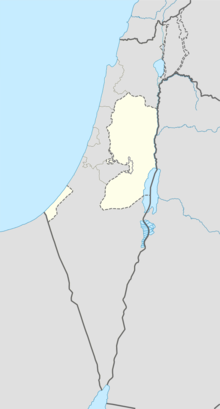Naaran
 Remnants of Naaran synagogue mosaic | |
| Location | West Bank |
|---|---|
| Coordinates | 31°53′37″N 35°25′28″E / 31.89361°N 35.42444°E |
Naaran (also Na'aran) (Hebrew: נערן) was an ancient Jewish village dating to the 5th and 6th century CE, located in the modern-day West Bank. Remains of the village have been excavated north-west of Jericho. Naaran is archeologically notable for a mosaic floor of a synagogue, featuring a large zodiac design, which was discovered at the site.
Naaran is identified with Ein ad-Duk, now within the municipal boundaries of Jericho, 5km north-west of the city center.
Settlement[edit]
Naaran is mentioned in Joshua 16:7 and 1 Chronicles 7:28 as a town in the eastern part of Ephraim.[1] Eusebius, in his Onomasticon, makes mention of the site, saying that in his day it was "a village inhabited by Jews, five [Roman] miles from Jericho."[2] The site is also named in the writings of Josephus (Antiquities 17.13.1), under its Greek name Νεαρά,[3] and in the Midrash Rabba (Leviticus Rabbah 23:5), which notes the rivalry between Naaran and the neighboring gentile city of Jericho.[4]
Excavations in the vicinity of the synagogue have yielded structures dated to the Byzantine period.[5]
Synagogue[edit]
In 1918, during WWI in Palestine, a Turkish shell fired at Australian and New Zealand troops exposed part of a mosaic floor.[5] It was initially misidentified as a church, but later Charles Clermont-Ganneau recognised it as a synagogue.[5] Louis-Hugues Vincent conducted excavations in the 1920s, but the site remained largely untouched until the 1970s.[5]
Despite literary evidence of the antiquity of the settlement, little information about the age of the synagogue is available. Some scholars suggest the 5th and 6th centuries CE on architectural grounds.[5]
Aramaic inscriptions and mosaics from the synagogue are displayed at an archaeology museum established by the Israeli archaeologist Yitzhak Magen at the Good Samaritan Inn.[6]
An Israeli settlement, kibbutz Na'aran, located 8 kilometers to the north, takes its name from Naaran.
See also[edit]
- Shalom Al Yisrael Synagogue (6th century) in nearby Jericho
- Yitav, nearby Israeli settlement
- Oldest synagogues in the world
- Archaeology of Israel
- Zodiac mosaics in ancient synagogues
References[edit]
- ^ Easton's Bible Dictionary
- ^ Eusebius, Onomasticon - The Place Names of Divine Scripture, (ed.) R. Steven Notley & Ze'ev Safrai, Brill: Leiden 2005, p. 130 (§732) ISBN 0-391-04217-3.
- ^ Albright, W.F. (1924). "Excavations and Results at Tell el-Fûl (Gibeah of Saul) (1922-1923)". The Annual of the American Schools of Oriental Research. 4. American Schools of Oriental Research: 153 (note 3). JSTOR 3768487.
- ^ Sivan, Hagith (2008). Palestine in late antiquity. Oxford University Press. p. 60. ISBN 978-0-19-928417-7. OCLC 928745908.
- ^ a b c d e Werlin, Steven (2015). Ancient Synagogues of Southern Palestine, 300–800 CE. Brill. pp. 29–70. ISBN 978-90-04-29839-2.
- ^ Inn of the Good Samaritan Becomes a Museum

